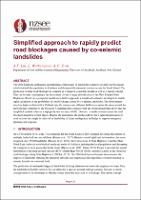| dc.contributor.author | Lin, Amelia | |
| dc.contributor.author | Wotherspoon, Liam | |
| dc.contributor.author | Zorn, Conrad | |
| dc.date.accessioned | 2023-08-28T04:23:19Z | |
| dc.date.available | 2023-08-28T04:23:19Z | |
| dc.date.issued | 2023-04-19 | |
| dc.identifier.uri | https://repo.nzsee.org.nz/xmlui/handle/nzsee/2548 | |
| dc.description.abstract | The 2016 Kaikōura earthquake triggered tens of thousands of landslides leading to several road blockages which isolated the population in Kaikōura and disrupted the transport services across the South Island. The prediction of these road blockages is complex as it requires a landslide model as well as a runout concept. This can be time consuming if the assessment covers a larger network such as the New Zealand State Highways. Based on a geospatial model and a buffer approach, a simplified method is developed to calculate the probability of road blockages caused by co-seismic landslides. The development involves high resolution New Zealand specific datasets and different buffers to capture the areas around the network that contribute to the blockage. Comparing the estimates with the observational data shows that the simplified method achieves a high prediction accuracy. However, it tends to overestimate the road blockage hazard in several places and shows potential for further improvement, for example, regarding the representation of the road blockage size. Despite the limitations, the method allows for a rapid identification of road sections that might be affected by landslides of future earthquakes and helps to support emergency planning and response. | |
| dc.language.iso | en | |
| dc.publisher | New Zealand Society for Earthquake Engineering | |
| dc.relation.ispartofseries | 2023;23 | |
| dc.subject | Understanding seismic hazard and risk | |
| dc.title | Simplified approach to rapidly predict road blockages caused by co-seismic landslides | |
| dc.type | Article | |

